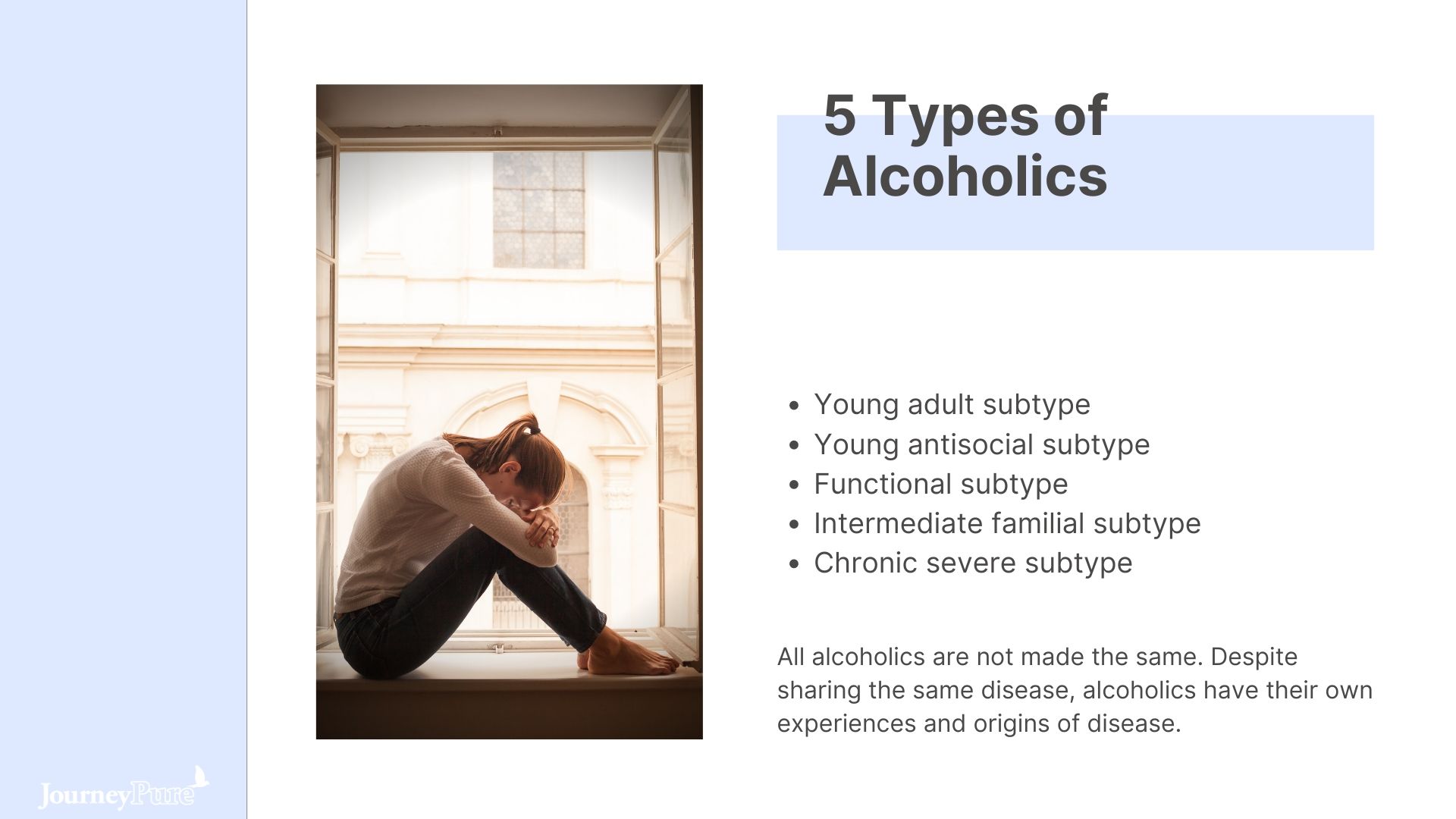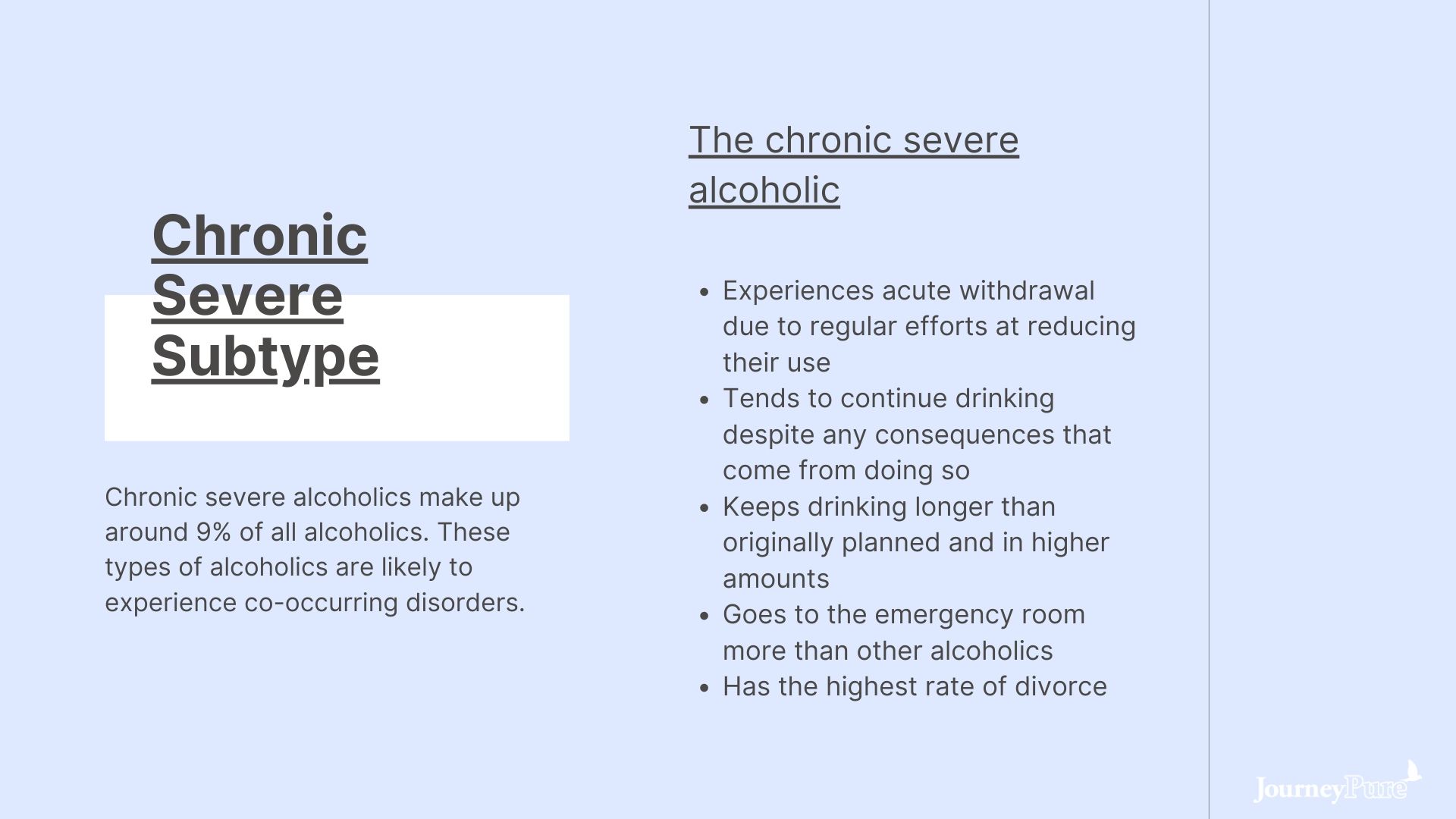More than 14 million American adults struggle with the disease of alcoholism. This disease tears through friends and families at a rate almost unimaginable. In today’s world, if you are not struggling with alcoholism on a personal level, chances are you know someone who is.
But did you know that there are different types of alcoholics? Like most else in the world, all alcoholics are not made the same. Despite sharing the same disease, alcoholics have their own experiences and origins of disease. These differences are what separate types of alcoholics.

TYPES OF ALCOHOLICS
There are five types of alcoholics:
- Young adult subtype
- Young antisocial subtype
- Functional subtype
- Intermediate familial subtype
- Chronic severe subtype
YOUNG ADULT SUBTYPE
Making up more than 31% of all alcoholics, the young adult subtype is by far the most common type of alcoholic in the United States. The average age of the young adult subtype is 25, with many in the category developing a dependence to alcohol by the age of 20. A large portion of individuals in this category of alcoholics become alcoholics during their college years, where alcohol is deeply ingrained into the college experience. It can be extremely difficult to tell if someone is addicted to alcohol or not at this time, as it is normal to drink regularly and to excess. Plus, the peers of the young adult subtype are not always aware of the warning signs of alcoholism and can easily excuse away abnormal drinking behaviors.
The young adult subtype is not entirely made up of college students, as there are also many young adults who struggle with alcoholism who are already in the workforce and/or unemployed. Studies do show that those young adult subtype alcoholics who are not enrolled in college are more likely to have part-time jobs. One of the most concerning aspects about alcoholism in this age group is the damage alcohol can do to the brain, as the brain is still developing in important areas, such as in the prefrontal cortex.
Some of the characteristics of the young adult subtype include:
- Not drinking as frequently as others may, but binge drink when they do consume alcohol
- Not as likely as other alcoholics to have a co-occurring mental health disorder and/or a family member who is an alcoholic
- Rarely seek help for their alcoholism
- Developing a dependence on alcohol at a very young age (typically between 19-20 years old)
Alcoholics who fit into the young adult subtype are most likely to be male, as men are 2.5 times more likely to experience this type of alcoholism than women.

YOUNG ANTISOCIAL SUBTYPE
The young antisocial subtype is made up of more than 21% of all types of alcoholics. The antisocial aspect of this subtype refers to the fact that more than 50% of all alcoholics within this grouping experience antisocial personality disorder. Antisocial personality disorder is a mental health condition that usually develops in childhood but cannot be officially diagnosed until one’s teenage years. According to the Diagnostic and Statistical Manual of Mental Disorder (DSM), antisocial personality disorder is characterized by the following symptoms:
- Violation of the physical and/or emotional rights of others
- Irritability and aggression
- Consistent irresponsibility
- Lack of remorse
- Lack of stability in job and home life
- Deceitfulness
Not all young antisocial subtypes need to have antisocial personality disorder to fit into this category of alcoholics, as they may also have bipolar disorder, depression, or anxiety. Usually, however, there is an underlying mental health condition occurring at the same time as the alcohol abuse. One stand-out trait of the young antisocial subtype is that more than ¾ of all individuals in this category are male. The young antisocial subtype tends to:
- Have the lowest level of education
- Make the least amount of money
- Have trouble with employment
- Drink more in one sitting than most (as opposed to drinking frequently)
This group of alcoholics is, however, the most likely to reach out for professional help than any other type of alcoholic.

FUNCTIONAL SUBTYPE
The functional subtype is the alcoholic who nobody believes is really an alcoholic. That is because this alcoholic is functional in most every way, if not more. For example, functional subtypes are successful in maintaining employment, having good relationships with others, and keeping up with activities and hobbies that they enjoy. About 19% of all alcoholics are functional, with the majority of them being in their late 30’s to early 40’s. The functional subtype begins drinking later in their teenage years (around 18) and does not start to struggle with dependence until their late 30’s. Similar to the young antisocial subtype, 60% of all functional alcoholics are male.
The functional alcoholic typically has:
- A family
- A good education
- A family history of substance abuse (especially in a parent or sibling)
- Stable relationships
Statistics related to the functional alcoholic include the following:
- 25% have major depression
- 50% smoke cigarettes
- Less than 20% seek professional help
Of those functional alcoholics that seek treatment, the majority of them utilize a 12-Step program as their primary form of care. It is common to see functional alcoholics only participating in 12-Step programs or minimally invasive programs like outpatient treatment to address their alcoholism, as they feel they are capable of continuing to manage successfully on their own.
INTERMEDIATE FAMILIAL SUBTYPE
The intermediate familial subtype is 64% male and almost as active and successful as the functional subtype. These individuals usually have an immediate family member who has/had an alcohol use disorder, hence the labeling of their type of alcoholism. Out of all types of alcoholics, the intermediate familial subtype is the most employed, however, it usually does not make more than the functional subtype.
The intermediate familial subtype also:
- Has high rates of marijuana and cocaine use
- Experiences depression while drinking (50% of these types of alcoholics have this co-occurring disorder)
- May be part of the 20% of individuals in this group that have bipolar disorder
The intermediate familial subtype, on average, begins drinking around age 17 and starts struggling with dependence by their 30’s. Less than 30% of all intermediate familial alcoholics seek treatment for their disease.

CHRONIC SEVERE SUBTYPE
Chronic severe alcoholics make up around 9% of all alcoholics. Drinking for this group begins around age 15 and dependence is usually fully developed around age 29. These types of alcoholics are likely to experience the following co-occurring types of depression and anxiety disorders:
- Bipolar disorder
- Major depression
- Dysthymia
- Generalized anxiety disorder
- Social phobia
- Panic disorder
Roughly 50% of all chronic severe alcoholics display symptoms in line with antisocial personality disorder, such as deceitfulness, lack of remorse, and violating the emotional and physical right of others. Although many chronic severe alcoholics exhibit these symptoms, they typically do not fit the mold of the young antisocial alcoholic because of other defining factors (such as those previously discussed).
The chronic severe alcoholic also:
- Experiences acute withdrawal due to regular efforts at reducing their use
- Tends to continue drinking despite any consequences that come from doing so
- Keeps drinking longer than originally planned and in higher amounts
- Goes to the emergency room more than other alcoholics
- Has the highest rate of divorce
This group of alcoholics are the most likely to reach out for help through inpatient treatment programs, as well as through 12-Step groups and detox services.
Addiction recovery that’s built to last
DANGERS OF ALCOHOL ADDICTION
Regardless of which type of alcoholic someone is, the potential risk for health problems or death are alarming. Alcoholism is the 3rd leading lifestyle-related cause of death with around 88,000 deaths reported each year. And while not everyone loses their lives to alcoholism, many suffer impacts of their drinking that threaten their wellbeing both short and long-term.
Some of the most immediate dangers associated with alcohol addiction can include, but are not limited to, the following:
- Problems on the road, such as car accidents, getting tickets, being charged with a DUI, etc.
- Increased risk of physical injury related to being under the influence (e.g. broken bones, sprains, concussions, burns, lacerations, etc.)
- Potential for dangerous chemical interactions if drinking when taking other addictive substances or medications
- Suffering alcohol poisoning as a result of drinking too much in a short period of time
As time passes and alcohol is still being consumed, an alcoholic can start to experience more serious issues, such as:
- Cirrhosis of the liver
- Liver damage
- Liver failure
- Liver disease
- Stroke
- Dementia
- Neuropathy
- Heart disease
- Increased risk for cancer (especially cancers in the liver, mouth, and throat)
Alcohol addiction, no matter what type of alcohol you may be, is a deadly disease unless you obtain treatment for it. Continuing to drink will only put you at greater risk for destroying your physical, mental, and emotional wellbeing.
GET HELP TODAY BY CALLING JOURNEYPURE
If you are an alcoholic and need help, there is no time to waste. You deserve to get the care that will help you make your active addiction a thing of the past.
So, do not wait. Call us right now. At JourneyPure, we can help you overcome your battle with alcoholism and begin living a happy, healthy life. Call today.
